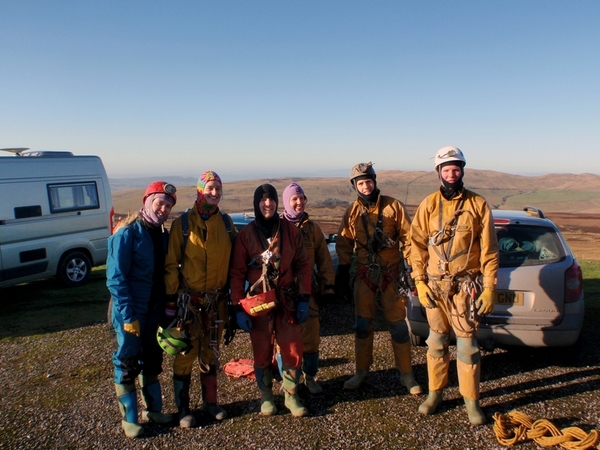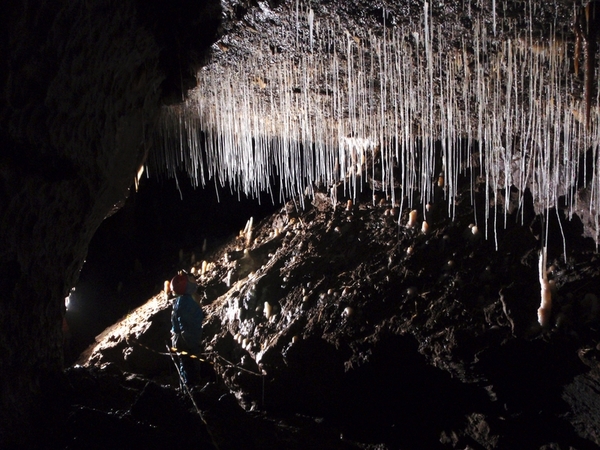Great to get the chance to explore the recently discovered Shuttleworth Pot.
We parked at the top car park of Leck Fell by Leck Fell House (as the lower car park was full) and followed the wall down the fell for some distance, before deviating off towards the entrance at grid reference SD 6621 7978. Our GPS took us straight to the entrance, just above an obvious but small rocky outcrop before you reach the bottom of the valley.
The entrance pipe was 3m deep assisted by an in-situ aluminium ladder. A cut away section at the bottom of the pipe leads immediately onto the first short pitch with an in-situ deviation a few metres down. (20m rope is excessive but would cover the entrance pipe too if the aluminium ladder were absent for whatever reason).
A short crawl below the entrance pitch reaches a junction, left into a standing height rift (not explored), but right reaches after only a couple of metres the start of a series of pitches leading down into the main caverns of Shuttleworth Pot. A single 60m rope allows all these pitches to be rigged, or several shorter lengths would work. All these pitches have P-hangers installed in suitable locations.
The first pitch in the series is 5m down through a narrow slot into a small chamber. Another 3m pitch follows immediately (the hang being from an in-situ sling around a natural), which could be easily climbed but best not owing to the large drop of the main pitch just beyond. This lands on a large ledge over the main pitch.
For the main pitch the hanger is high up on the right at the pitch head and rope rub about a foot below the hanger is unavoidable, so we rigged this from a figure 8 with a very long loop (so the loop sat on the rub point rather than the main rope). A long sling would probably work better. A descent of 5-6m reaches a re-belay at a convenient shelf. A further descent of several metres reaches the next re-belay at a smaller shelf. The final descent of approximately 15m reaches the floor, although you need to kick-out for the last several metres to avoid rope rub.
We then followed the taped route up the slope and spent a few hours being amazed by the superb unspoilt formations, including an excellent gallery of straws and some superb flowstone and helictites (no route description is necessary for this, it's all very obvious). I would appeal to all future visitors to please take your time and to watch where your hands, feet and head is going as several formations are in very vulnerable locations indeed and some damage has already been done.
Back at the bottom of the pitch, we decided to complete the trip by descending to the sump. Although you could climb down the rubble slope we were advised that this was unstable and it is preferable to rig a traverse from the bolts around the right hand wall to a short pitch with a deviation a few metres down. From the bottom, stay on the rope with a short traverse line away from the sump to avoid all risks of slipping into the turbulent sump pool which would undoubtedly be serious. A 35m rope is sufficient for the traverse and pitch.
The sump is extremely impressive. An ascending slope goes steeply up for about 50m to a short muddy section of passage with some gour pools and mud formations, but this soon closes down at a muddy dig and the short Zig Zag passage on the right.
The walk back to the car was the hardest part of the trip, as we parked at Leck Fell, meaning a long (40+ min) walk uphill across awkward terrain! This could possibly be avoided in future by instead parking at Bull Pot Farm. The entire trip time was much longer than expected (from leaving the car to getting back, about 6 hours), however we were a large group, taking our time and stopping for regular photos.
A superb trip! Congratulations to all those involved in the discovery.
Tackle guide for future visits:
- Entrance pitch – 20m rope
- Main pitch series – 60m rope or 25+40m
- Pitch to sump (including traverses) – 35m rope
As at January 2012 the entire cave is eco-hangered except the traverse and pitch down to the sump which has adequate longlifes.
More articles
Exploration of the Excalibur MEGA extensions
By Matt Ewles | 14 Aug 2025
Excalibur streamway extended!
By Matt Ewles | 7 Aug 2025
Dan-yr-Ogof Far North
By Matt Ewles | 27 May 2025
Brown Hill Pot
By Matt Ewles | 22 Apr 2024
Sunny Bank Holiday in Wales
By Matt Ewles | 5 Jun 2023
Avoiding the January Blues in Rift Pot
By Tash Durham | 16 Jan 2023
North Wales Slate Mines 2022
By Matt Ewles | 5 Dec 2022
Long Churn beginners trip. 10th October 2022
By Conor Morrison | 11 Oct 2022
Covid Extensions surveying complete!
By Matt Ewles | 1 Sep 2022
Mountaineering in North Wales
By Matt Ewles | 1 Sep 2022

